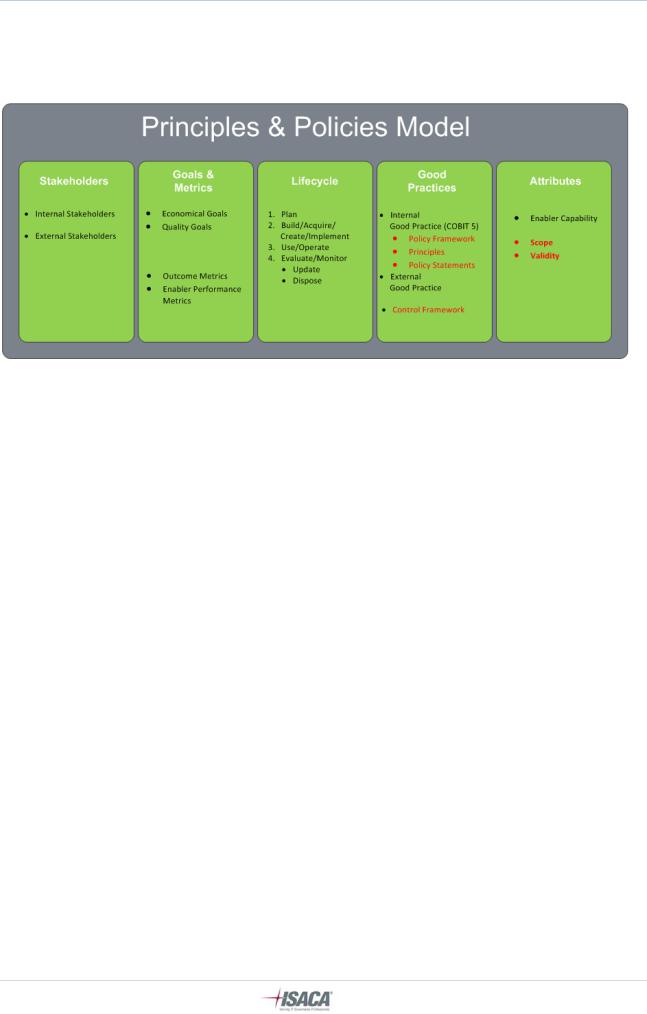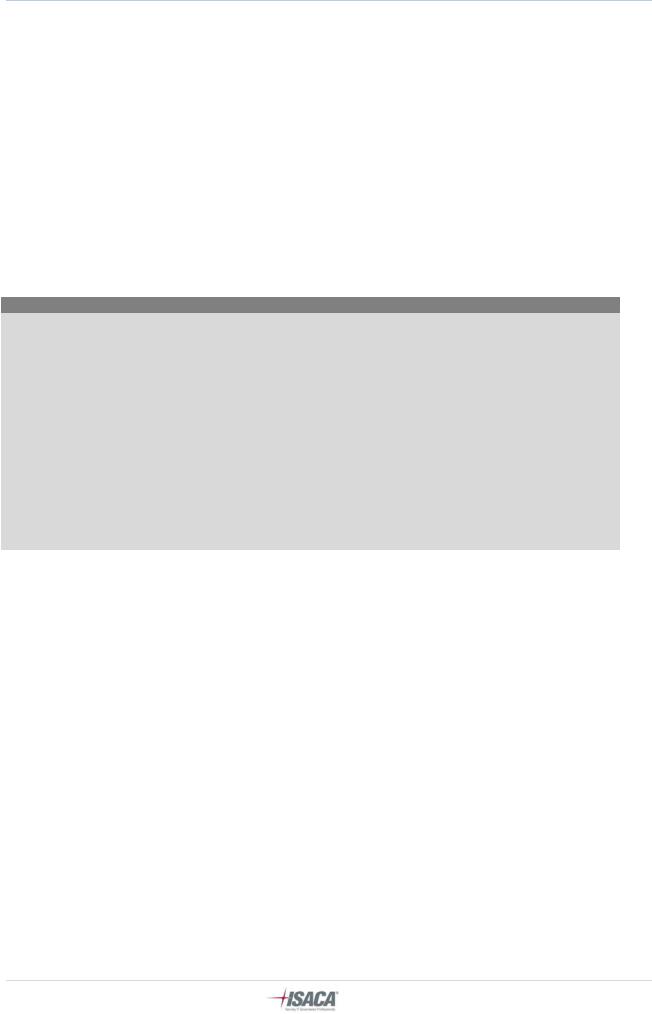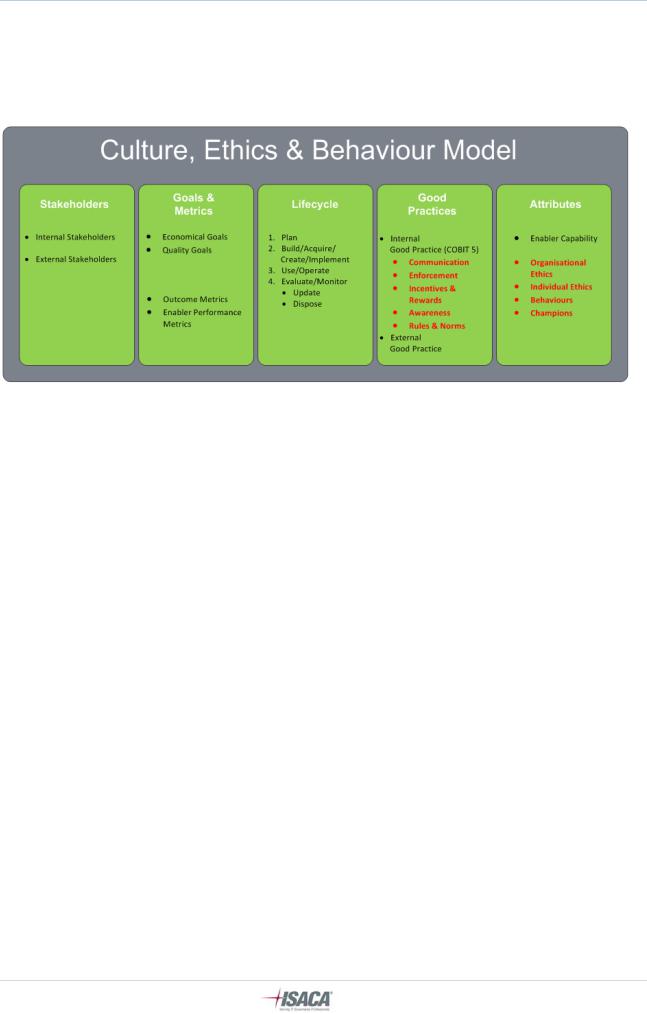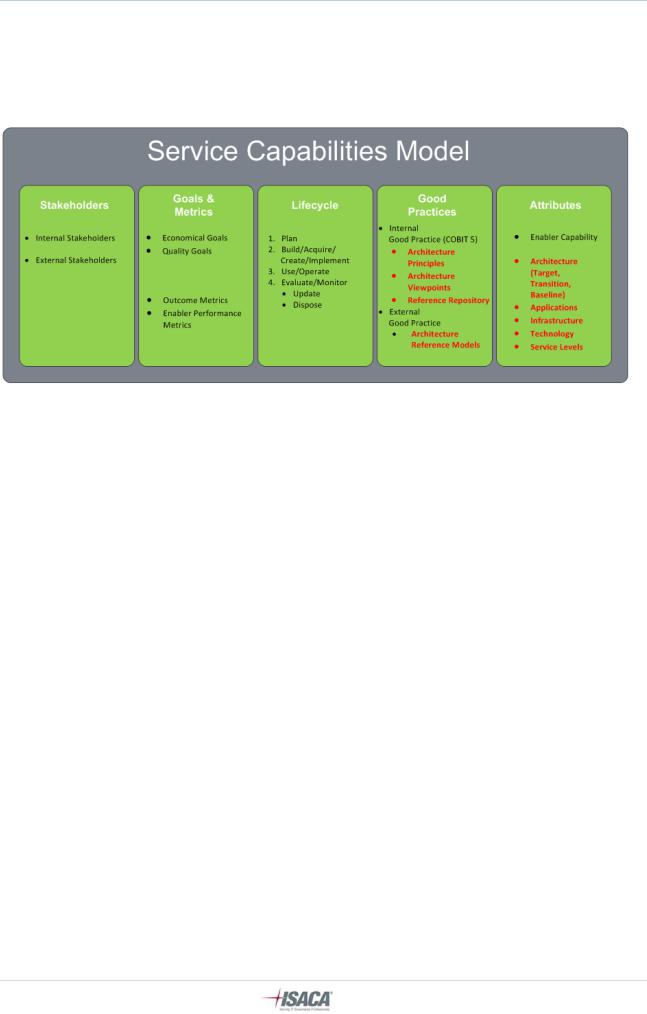
Ещё одна посылка от Водяхо / Cobit-5-EN-Framework-DRAFT
.pdf
COBIT 5: Framework Exposure Draft
COBIT 5 Principles and Policies Model
The principles and policies model, based on the generic COBIT 5 enabler model, is shown in figure 43.
Figure 43—COBIT 5 Principles and Policies Model
Stakeholders—Principles and policies stakeholders can be internal and external to the enterprise. They include board and executive management, compliance officers, risk managers, internal and external auditors, service providers and customers, regulatory agencies, etc. The stakes are twofold: some stakeholders define and set policies, others have to align to and comply with policies.
Goals and metrics—Policies and procedures are instruments to communicate the rules of the organisation in support of the governance objectives and enterprise values, as defined by the board and executive management. Principles need to be:
•Limited in number
•Put in simple language, expressing as clearly as possible the core values of the enterprise
Policies provide more detailed guidance on how to put principles into practice and they influence how decision making aligns with the principles. Good policies are:
•Effective—They achieve the stated purpose.
•Efficient—They ensure that principles are implemented in the most efficient way.
•Non intrusive—They appear logical for those who have to comply with them, i.e., they do not create unnecessary resistance.
Life cycle —Policies have a life cycle, too. In that context, the policy framework is key. It provides the structure in which a consistent set of policies can be created and maintained, and it provides an easy point of navigation within and between individual policies.
Depending on the external environment in which the enterprise operates, there can be varying degrees of regulatory requirements for strong internal control and, as a consequence, a strong policy framework. Some key attention points to be taken into account include:
•Access to policies—Is there a mechanism in place that provides easy access to policies for all stakeholders? In other words, do stakeholders know where to find policies?
•Currency of policies—If and when policies are reviewed and updated, are there strong mechanisms in place to ensure that people are aware of these updates, that the newest version is easily accessible (see previous point), and that obsolete copies are disposed of?
Good practices:
1.Good practice requires that policies be part of an overall policy and control framework, providing a (hierarchical) structure into which all policies should fit and clearly making the link to the underlying principles.
2.As part of the policy framework, the following items need to be described: a. The consequences of failing to comply with the policy
80 | P a g e |
© |
A l l r i g h t s r e s e r v e d . |

COBIT 5: Framework Exposure Draft
b.The means for handling exceptions
c.The manner in which compliance with the policy will be checked and measured
3.Generally recognised control frameworks can provide valuable guidance on the actual policy statements to be included in policies.
4.Policies should be aligned with the organisation’s risk appetite. Policies are a key component of an enterprise’s system of internal control, whose purpose it is to manage and contain risk. As part of risk
governance activities, the enterprise’s risk appetite is defined, and this risk appetite should be reflected in the policies. A risk averse organisation has stricter policies than a risk aggressive organisation.
Attributes—Principles and policies have some specific attributes, such as scope and validity, describing their applicability. Policies need to be re validated and/or updated at regular intervals.
Relationships with other enablers—There are many links with the other enablers, e.g.:
•Policies should reflect the culture and ethical values of the enterprise, and they should encourage the desired behaviour, hence a strong link with the culture, ethics and behaviour enabler.
•Process practices and activities are the most important vehicle for executing policies.
•Organisational structures can define and implement policies within their span of control, and their activities are also defined by policies.
EX A M P L E 15
An enterprise is considering how to deal with the fast rising use of social media and pressure from its staff to have full access. Until now, the organisation has been conservative or restrictive in granting access to this kind of service, mainly for security reasons.
There is pressure from different sides to take another position with regard to social media. Staff wants similar levels of access as it has from home, but the organisation itself also wants to use and exploit the benefits of social media for marketing and public awareness raising purposes.
The decision is taken to define a policy on the use of social media on the enterprise’s networks and systems, including laptops provided by the enterprise to its staff members. The new policy fits in the existing policy framework under the category of ‘acceptable use policies’, and it is more relaxed than previous policies. As a consequence, communication is developed to explain the reasons for the new policy. At the same time, there is also impact on some other enablers:
•Staff needs to learn how to deal with the new media in order not to create embarrassing situations for the enterprise, i.e., learning the right behaviour in line with the new direction the enterprise is taking and developing the right skills
•A number of processes with regard to security need to be changed; access is opened up to these media, so security settings and configurations have to change and possibly some compensating measures need to be defined.
81 | P a g e |
© |
A l l r i g h t s r e s e r v e d . |

COBIT 5: Framework Exposure Draft
COBIT 5 Culture, Ethics and Behaviour Model
Human behaviour is one of the key factors determining the success of any enterprise, and the COBIT 5 model for culture, ethics and behaviour (figure 44) provides a number of components that need to be taken into account.
Figure 44—COBIT 5 Culture, Ethics and Behaviour Model
Stakeholders Culture, ethics and behaviour stakeholders can be internal and external to the enterprise. Internal stakeholders include the whole enterprise, external stakeholders include regulators, e.g. external auditors or supervisory bodies. Stakes are twofold: some stakeholders deal with defining, implementing and enforcing desired behaviours, e.g. legal officers, risk managers, HR managers, remuneration boards and officers, etc., others have to align with the defined rules and norms.
Goals & Metrics – goals and metrics can either relate to instances of desired/undesired behaviour (outcome metrics), or they can relate to the culture and behaviour changing techniques and measure put in place (performance measures).
Lifecycle – an organisational culture, individual behaviours, etc. all have their lifecycles. Starting from an existing culture, an organisation can identify required changes and work towards their implementation. Several tools – described in the good practices – can be used for that.
Good practices—Good practices for creating, encouraging and maintaining desired behaviour throughout the organisation include:
•Communication throughout the enterprise of desired behaviours and the underlying corporate values
•Awareness of desired behaviour, strengthened by the example behaviour exercised by senior management
•Incentives to encourage and deterrents to enforce desired behaviour. There is a clear link between individual behaviour and the HR reward scheme an enterprise puts in place.
•Rules and norms, which provide more guidance on desired organisational behaviour. This links very clearly to the principles and policies an organisation puts in place.
5.Attributes—Specific attributes for culture, ethics and behaviour include:
•Organisational ethics, determined by the values the enterprise wants to live by
•Individual ethics, determined by the personal values of each individual in the organisation and depending to a important extent on external factors such as religion, ethnicity, socio economic background, geography and personal experiences
•Behaviours, which collectively determine the culture of an organisation. Many factors drive behaviours, e.g., the external factors mentioned above but also interpersonal relationships in enterprises, personal objectives and ambitions. Some types of behaviours that can be relevant in this context include:
-Behaviour toward taking risk—How much risk does the enterprise feel it can absorb and which risks is it willing to take?
-Behaviour toward following policy—To what extent will people embrace and/or comply with policy?
82 | P a g e |
© |
A l l r i g h t s r e s e r v e d . |

COBIT 5: Framework Exposure Draft
-Behaviour toward negative outcomes—How does the enterprise deal with negative outcomes, i.e., loss events or missed opportunities? Will it learn from them and try to adjust, or will blame be assigned
without treating the root cause?
Relationships with other enablers—Culture is an important influencer or even critical success factor for a number of other enablers, e.g.:
•Processes can be designed to a level of perfection, but if the stakeholders of the process do not wish to execute the process activities as they should, i.e., if their behaviour is one of non compliance, process outcomes will fall short.
•Likewise, organisational structures can be designed and built according to the textbook, but if their decisions are not implemented—for reasons of different personal agendas, lack of incentives, etc.—they will not result in decent governance and management of enterprise IT.
•Principles and policies are a very important communication mechanism for corporate values and the desired behaviour.
EX A M P L E 16
An enterprise is facing repeatedly serious quality problems with new applications. Despite the fact that a sound software project development methodology is in place, all too often software problems cause operational problems in day to day business.
An investigation shows that the development team members and management are evaluated and rewarded based on the timely delivery, within budget, of their projects. They are not measured against quality criteria or business benefits criteria. As a consequence, they focus diligently on delivery time and cost cutting during development, e.g., on testing time. The investigation also shows that compliance with the established methodology and procedures is virtually non existent, because it would take some more time from the development budget (in favour of quality). In addition, the organisational structure is such that the official involvement of development stops when the development has been handed over to the operations team. From then on, development’s involvement is only indirect, through the established incident management and problem management processes.
The lesson learned is that better incentives must be used for the solutions development management and teams, in order to encourage quality in their work.
EX A M P L E 17
Some symptoms of an inadequate or problematic culture with regard to IT related risk include:
•Misalignment between real risk appetite and translation into policies. Management’s real values toward risk can be reasonably aggressive and risk taking, whereas the policies that are created reflect a much more conservative attitude. Hence, there is a mismatch between values and the means to realise the values, inevitably leading to conflict. Conflicts may arise, for example, between the incentives set for management and the enforcement of misaligned policies.
•The existence of a ‘blame culture’. This type of culture should by all means be avoided; it is the most effective inhibitor of relevant and efficient communication. In a blame culture, business units tend to point the finger at IT when projects are not delivered on time or do not meet expectations. In doing so, they fail to realise how the business unit’s involvement up front affects project success. In extreme cases, the business unit may assign blame for a failure to meet the expectations that the unit never clearly communicated. The ‘blame game’ only detracts from effective communication across units, further fuelling delays. Executive leadership must identify and quickly control a blame culture if collaboration is to be fostered throughout the enterprise.
83 | P a g e |
© |
A l l r i g h t s r e s e r v e d . |

COBIT 5: Framework Exposure Draft
COBIT 5 Service Capabilities Model
The service capabilities model, based on the generic COBIT 5 enabler model, is shown in Figure 45. Service capabilities refer to resources such as applications and infrastructures that are leveraged in the delivery of IT related services.
Figure 45—COBIT 5 Service Capabilities Model
Stakeholders Service capabilities stakeholders can be internal and external; services can be delivered by internal or external parties – think internal IT departments, operations managers, outsourcing providers; users of services can also be internal – think business users – and external to the organization, e.g. partners, clients, suppliers. The stakes of each of the stakeholders need to be identified and will either be focused on delivering adequate services, or on receiving required services from providers.
Goals & Metrics – Goals and metrics for service capabilities are linked to service levels, where both quality aspects and economical aspects will need to be defined.
Life cycle—Service capabilities have a life cycle. The future or planned service capabilities are typically described in a target architecture. It covers the building blocks, such as future applications and the target infrastructure model, and also describes the linkages and relationships amongst these building blocks.
The current service capabilities that are used or operated to deliver current IT services are described in a baseline architecture. Depending on the time frame of the target architecture, a transition architecture may also be defined, which shows the enterprise at incremental states between the target and baseline architectures.
Good practices—Good practice for service capabilities includes:
•Definition of architecture principles. Architecture principles are overall guidelines that govern the implementation and use of IT related resources within the enterprise. Examples of potential architecture principles are:
-Re use—Common components of the architecture should be used when designing and implementing solutions as part of the target or transition architectures.
-Buy vs. build—Solutions should be purchased unless there is an approved rationale for developing them internally.
-Simplicity—The enterprise architecture should be designed and maintained to be as simple as possible while still meeting enterprise requirements.
-Agility—The enterprise architecture should incorporate agility to meet changing business needs in an effective and efficient manner.
-Openness—The enterprise architecture should leverage open industry standards.
•The enterprise’s definition of the most appropriate architecture viewpoints to meet the needs of different stakeholders. These are the models, catalogues and matrices used to describe the baseline, target or transition architectures. For example, an application architecture could be described through an application interface diagram, which shows the applications in use (or planned) and the interfaces amongst them.
84 | P a g e |
© |
A l l r i g h t s r e s e r v e d . |

COBIT 5: Framework Exposure Draft
•Having an architecture repository, which can be used to store different types of architectural outputs, including architecture principles and standards, architecture reference models, and other architecture deliverables
External good practice for architecture frameworks and service capabilities exist. These are guidelines, templates or standards that could be used to fast track the creation of architecture deliverables. For example:
•The Open Group Architecture Framework (TOGAF)15 provides a Technical Reference Model and an Integrated Information Infrastructure Reference Model.
•ITIL provides comprehensive guidance on how to design and operate services.
Attributes—Attributes specific for service capabilities include:
•The architecture viewpoints, as discussed previously
•Service levels that need to be defined and achieved by the service providers
•The building blocks of services, i.e.:
-Applications, providing business functionality
-Technology infrastructure, including hardware, system software, networking infrastructure, etc.
-Physical infrastructure
Relationships with other enablers—There are links between service capabilities and other enablers in COBIT 5. Information is one of the service capabilities, and service capabilities are leveraged through processes to deliver internal and external services.
Cultural and behavioural aspects are also relevant when a service oriented culture needs to be built.
Within COBIT 5, the inputs and outputs of the management practices and activities could include service capabilities, which are required as inputs or delivered as outputs.
15 www.opengroup.org/togaf/
85 | P a g e |
© |
A l l r i g h t s r e s e r v e d . |
